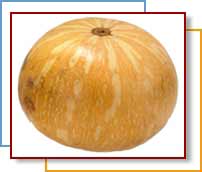Home | FOOD ARTICLES | Food Trivia | Today_in_Food_History | Food_History_Timeline | Recipes | Cooking_Tips | Food_Videos | Food_Quotes | Who’s_Who | Culinary_Schools_&_Tours | Food_Trivia_Quizzes | Food_Poems | Free_Magazines | Food_Festivals_and_Events
Food Articles, News & Features Section
You are here > Home > Food Articles >
FREE Magazines
and other Publications
Free Professional and Technical Research, White Papers, Case Studies, Magazines, and eBooks
CALABAZA SQUASH, West Indian Pumpkin
Calabaza is a type of pumpkin-like squash that is round in shape and varies in size. It can be as large as a watermelon or as small as a cantaloupe. The color of calabaza can also vary and may include greens, tans, reds and oranges. Some squash are all one color while other calabaza are multi-colored and may include all of colors listed above.
This squash is popular in the Caribbean as well as Central and South America. It is also commonly called a West Indian Pumpkin.
Selection

Calabaza is often sold already chopped into chunks in many Latin markets. This is because of the difficulty many have in chopping the whole squash*. Select pieces with a fresh, moist and unblemished flesh. Soft or wet spots means the squash is beginning to spoil. The color of the flesh should be a bright orange. Whole squash are more difficult to find, but if you find one, select one that still has the stem attached and is heavy for its size. You should avoid purchasing a squash with bruises, cuts, or soft spots. Calabaza is available year round.
Storage
Whole calabaza may be stored in a cool, dry space for up to 6 weeks. Cut calabaza should be wrapped tightly or placed in a covered container in the refrigerated for no more than one week.
Preparation
Calabaza has a sweet flavor and its texture is firm. This is similar to the taste and texture of more familiar varieties of squash, such as butternut or acorn. Calabaza may be substituted in recipes calling for those more common types of squash.
Calabaza is most commonly baked, either cut in sections or in cubes. Its seeds may also be roasted in a similar way as pumpkin seeds. Simply place on a baking sheet coated in cooking spray until brown and crisp.
*Word to the Wise
Whole calabaza may be difficult to slice. Slicing through the tough rind often calls for a heavy cleaver or a very sharp knife. If the squash resists slicing, remove the stem and place the knife or cleaver blade along the squash’s length. Gently tap the blade with a hammer until the squash falls open. Scoop out the seeds, peel and prepare!
RELATED ARTICLES
Please feel free to link to any pages of FoodReference.com from your website.
For permission to use any of this content please E-mail: james@foodreference.com
All contents are copyright © 1990 - 2026 James T. Ehler and www.FoodReference.com unless otherwise noted. All rights reserved.
You may copy and use portions of this website for non-commercial, personal use only.
Any other use of these materials without prior written authorization is not very nice and violates the copyright.
Please take the time to request permission.
